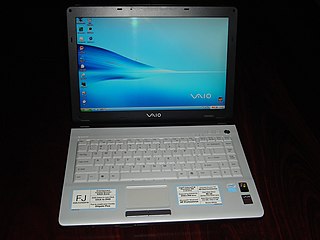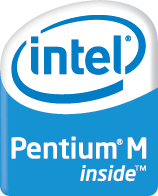The Sony U series of subnotebook computers refers to two series of Sony products the PCG-U and the VGN-U. The later VGN-U were, at their release, the smallest independent computers running Windows XP and the most powerful high-end subnotebooks at the time. The VGN-U50 and VGN-U70P models are roughly the size of two DVD cases stacked on top of each other.

The Samsung Q1 was a family of Ultra-Mobile PCs produced by Samsung with a 7" (18 cm) LCD and exists in several different versions with either Windows XP Tablet PC Edition or Windows Vista Home Premium

The HP Compaq TC1100 is a tablet PC sold by Hewlett-Packard that was the follow-up to the Compaq TC1000. The TC1100 had either an Intel Celeron or an Intel Pentium M chip set and could be upgraded up to 2 gigabytes of memory. The switch from Transmeta Crusoe processors to the Pentium M and the ability to add memory was welcomed after numerous complaints about the poor performance of the TC1000. The TC1100 was the last version from HP in this style of tablet. It was replaced by the HP Compaq TC4200, which featured a more traditional one-piece design.
The Compaq Presario 3000 series was a line of notebook computers produced between 2000 and 2001 by Compaq. They are noted for their Intel processors, desktop-like feature list, heat, heavy weight and 16-inch LCD screens.

The Sony Vaio FJ series is a 14.1 inch notebook designed for Windows XP and the FJ270, FJ290, FJ330,FJ370 models in particular, are designed for Windows Vista. The FJ Series uses only the Pentium M processors using the Sonoma platform of Intel Centrino.

The Asus Eee PC is a netbook computer line from Asus, and a part of the Asus Eee product family. At the time of its introduction in late 2007, it was noted for its combination of a lightweight, Linux-based operating system, solid-state drive (SSD), and relatively low cost. Newer models added the options of Microsoft Windows operating system and rotating media hard disk drives (HDD), and initially retailed for up to 500 euros.

HP TouchSmart is a series of tablet PC laptops and touchscreen all-in-one desktop computers designed by HP. It features various Intel or AMD processors and runs Windows Vista or Windows 7 as standard.

The Sony Vaio P series is a range of ultraportable subnotebook computers launched in January 2009.

Sony Vaio FW is a discontinued series of notebook computers which were the first laptops ever to have a 1080p 16.4" 16:9 widescreen LCD. Higher end models in the series can support an integral Blu-ray Disc reader or writer. The laptop weighed 3.1 kg. The battery lasts up to 2 hours. In June 2009, the ATI Mobility Radeon HD 3650 was replaced by the ATI Mobility Radeon HD 4650 with the release of the FW 4xx series. Additionally, Sony also released a special model of this series apart from the signature series models (Model:VGN-FW590FFD). This model had a futuristic themed cover and came equipped with moderately high-end specifications for $1069.99 U.S. dollars. The VGN-FW590FFD model was also only available for purchase through Sony Style's website.

The Vaio C1 PictureBook series is a series of subnotebooks from Sony's Vaio brand, branded 'Picturebook' for its webcam and video capture capabilities. It was first released on September 19, 1998, in Japan only.
The Sony Vaio 505 series was a line of ultraportable notebook computers from Sony's VAIO brand. The introduction date in the United States was July 24, 1998.
The Sony Vaio 700 series were Sony's first Vaio branded laptops, starting with the 705 and 707 models, launched in Japan on July 1, 1997, and subsequently in the United States.
The Sony Vaio 800 series was a range of Vaio laptops launched in 1998. It was produced until early 1999.
The Vaio F series is Sony's current multimedia and gaming orientated laptop. Launched in January 2010, it replaced the Sony Vaio FW series. Like the preceding model, it features a 16.4" screen, but with Full HD 1920x1080 resolution, 240Hz refresh rate, and LED backlight. The model came in two choices, 2D or 3D models. The 3D model is included with 3D glasses.
Sony VAIO AR series was a range of high-end multimedia notebook computers from Sony introduced in June 2006 as the first laptop with integrated Blu-ray drive. It replaced the AX Series. It featured a 17" 16:10 widescreen LCD screen, with choice of 1440x900 or 1920x1200 resolutions. It was replaced by the AW series.
The Vaio AX series was a range of multimedia notebook computers from Sony introduced in October 2005 running Windows XP Media Center Edition 2005. It replaced the A Series. It featured a 17" 16:10 widescreen LCD screen with 1440x900 resolution. It was replaced by the AR series.
The Vaio Y series is a line of notebook computer from Sony introduced in January 2010. It is a netbook-inspired model designed for travel use: compared with the other 13.3" models in the Vaio range, the Y lacks an optical drive, and is heavier and cheaper than the premium Sony Vaio Z series, but lighter than the consumer-grade Sony Vaio S series, with better battery life than either, thanks to the use of CULV processors. The weight is 3.92lbs (1.78kg).
The Sony Vaio FS series is a discontinued range of laptops sold by Sony. It was launched in January 2005 and featured an Intel Pentium M at 1.6 or 1.73 GHz with 512 MB of RAM and Intel GMA 900 or nVidia Geforce 6200 graphics. The screen was a 15.4" 1280x800 display with an 80 GB or 100 GB 4200 rpm hard drive, DVD playback and CD burner and 802.11b/g wi-fi. It weighed 2.9 kg.

The IBM ThinkPad 600 series was a series of notebook computers introduced in 1998 by IBM as the immediate predecessor to the T-series which still exists today under Lenovo ownership. Three models were produced, the 600, 600E, and 600X; the series was succeeded in 2000 by the ThinkPad T20 series.

The IBM ThinkPad T20 series was a series of notebook computers introduced in May 2000 by IBM as the successor of the 600 series and the first model of the T-series which exists today under Lenovo ownership. Four models were produced, the T20, T21, T22, and T23; the series was succeeded in May 2002 by the ThinkPad T30, but was produced until July 2003.












